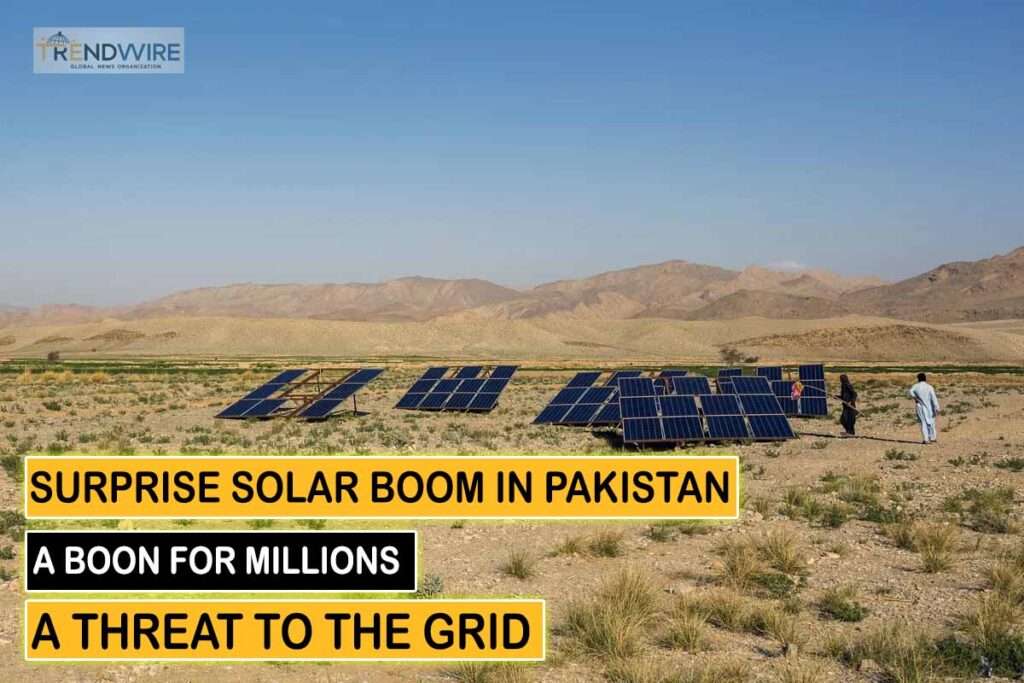Surprise Solar Boom in Pakistan: A Boon for Millions, a Threat to the Grid
In the heart of Pakistan’s agricultural landscape, a quiet revolution is taking place. Rows of solar panels are replacing traditional energy sources, promising financial relief to millions of households, industries, and farmers. However, this solar surge is also creating ripple effects that could destabilize the country’s fragile power grid and economy.

Solar Energy: A Growing Trend
Pakistan has seen a staggering rise in solar equipment imports, primarily from China, with $1.7 billion worth of solar panels purchased in the first nine months of this year alone, according to BloombergNEF. This is more than the total imports for 2023 and equates to 17 gigawatts of potential generation capacity—over one-third of the nation’s total power production.
Farmers like Mohammad Murtaza in Lahore have embraced solar energy, drastically reducing their power bills by switching from diesel-powered irrigation pumps to solar-powered ones. For Murtaza, solar panels have enabled him to plant three crops a year instead of two, slashing electricity costs by 80%.
“Ninety-five percent of farmland in this area has switched to solar,” he said, highlighting the unprecedented transformation sweeping across Pakistan’s rural economy.
Economic Relief, but at a Cost
The shift to solar is not just a trend—it’s a necessity. With electricity prices tripling since 2021 due to subsidy cuts mandated by the International Monetary Fund (IMF), solar power has become a lifeline for those who can afford it. The boom also aligns with Pakistan’s renewable energy goals, aiming for renewables to account for 60% of the energy mix by 2030.
However, the rapid and unregulated solarization has left state-owned utilities reeling. Losses of over PKR 2.4 trillion ($8.6 billion) since 2014 are mounting as more consumers abandon the national grid for cheaper solar solutions.
“There’s a great solar rush happening in Pakistan: the numbers are staggering,” said Muhammad Mujahid, executive director of Innovo Corporation. “But it’s creating the risk of a utility death spiral.”
A Struggling Grid and the Risk of Collapse
The influx of solar installations has reduced demand for grid electricity, putting immense pressure on power companies. The IMF has flagged retaining grid demand as crucial for economic stability, but balancing this with the growing shift to solar remains a challenge.
“If the government doesn’t cap solar capacity, most of the current generation fleet will become idle,” warned Syed Faizan Ali Shah, a member of the prime minister’s solarization committee.
Despite concerns, Pakistan’s Power Minister Awais Leghari remains optimistic. He emphasized the need for utilities to adapt, stating, “We all realize that the status quo can’t prevail.”
Solar Frenzy Fueled by Imports and Cricket Ads
The solar surge gained momentum after Pakistan lifted import restrictions in late 2023, making it the third-largest importer of Chinese panels. Solar panels now feature prominently in advertisements, from billboards to cricket matches, attracting households, factories, and even real estate firms into the solar business.
“Even industries producing cement and apparel are turning to solar due to frequent blackouts,” noted Usman Ahmad, CEO of solar distributor Nizam Energy Pvt.
Yet, official data on installations remains sparse. A satellite analysis by Norwegian firm Atlas identified 400 solar plants, but many smaller installations in homes and farms remain undocumented.
The Road Ahead: Boom or Bust?
While solar energy has brought financial relief and environmental benefits, experts warn of a potential bust. Jenny Chase, an analyst at BloombergNEF, predicts that the current unregulated growth could lead to significant challenges for the grid and the economy.
For millions of Pakistanis who cannot afford solar panels, the consequences of a failing electricity network could be disastrous.
“The grid is already sick, and this solar onslaught is happening in a very unsafe, unregulated way,” said Amin Sukhera, CEO of Sky Electric, a Pakistani solar firm.
A Balancing Act
Pakistan’s solar revolution underscores the need for careful planning and regulation. While the boom offers a glimpse of a renewable future, it also highlights the urgent need for reforms to maintain grid stability and protect the economy.
For now, Pakistan stands at an energy crossroads—one path leading to sustainability, the other to potential chaos.
Source: BloombergNEF
Follow Us on Social:
More Recent News
#SolarEnergy, #PakistanSolarBoom, #RenewableEnergy, #SolarPower, #CleanEnergy, #EnergyCrisis, #SolarPanels, #SustainablePakistan, #GreenEnergy, #EnergyTransition, #SolarGridImpact, #EnergySolutions, #SolarRevolution, #SolarFuture, #GridStability










